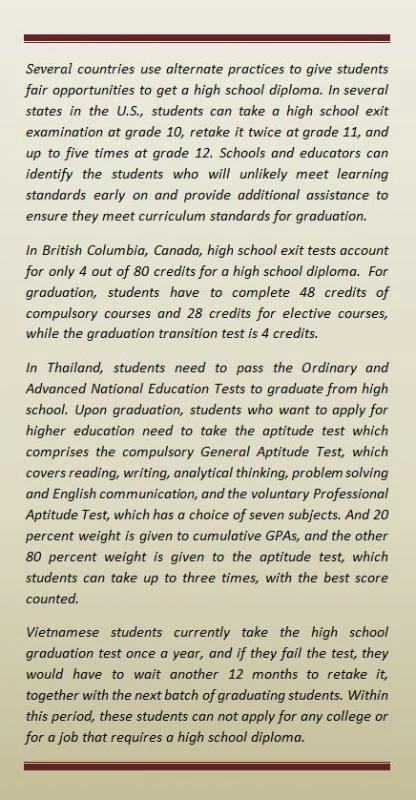
Photo: Van Chung/World Bank
After months of impassioned public discussion, Vietnam’s Ministry of Education and Training has finally announced that one national exam will determine high school graduation and the exam results will be used as the basis for university entrance admission.
Until recently, Vietnamese students took two tests after completing 12 years in school: one was for high school graduation and the next was for university entrance. Both were high stakes tests that created pressure on students and their families.
However, the two examinations served very different purposes. High school graduation tests are designed to assess important domains in the high school curriculum. They aim to ensure that high school graduates achieve required reading, writing and mathematical skills. High school graduation tests are not designed to test students on other skills such as learning skills, time management, team work, problem solving skills, creative skills, ICT skills, etc., which are important for readiness in post-secondary education (college or vocational school) and work.
University entrance examinations meanwhile aim to select the best students who will enroll in colleges. In several Asian countries like Vietnam, Korea, Japan and China, this is a national examination that takes place once a year after high school graduation examination. Only the highest scorers are selected to fill limited seats in universities and colleges. The tests aim to be a good predictor of future performance in professional careers (not just a measure of past learning).
First, the test must be designed so as to be both diagnostic of the level of achievement reached in secondary education, and highly predictive of future university performance. This will result in a lengthy test measuring different competencies at different performance levels. It will also require a lot of time to design and develop the test. In addition, a single cut-off score for the exam may be too high for high school graduation but still too low for university entrance selection.
Second, holding a single test may put extra pressure not only on students but also on educators and education managers, increasing the likelihood of cheating schemes and “teaching to the test” resulting in diverting valuable instruction time to test preparation and less on course curricula. These risks are associated with high-stakes tests, and could increase with a single test attempting to “do it all”. However, the bigger question is: Can a single exam tell whether a student is ready to graduate from high school and enter college?
International experience shows that standardized tests used in these large scale national assessments do not measure students’ important achievements. In order to develop better assessments geared at measuring high-order skills required for university-level study, and to be career-ready, different assessment methods should be used instead of relying solely on a test aimed at measuring past achievement and learning.
Other high quality assessment methods such as evidence of students’ performances, exhibits and portfolios should be employed to determine students’ skills, knowledge and disposition that are actually valued in university and employment. Combining these different sources of evidence gives a much better perspective of the readiness of students to exit secondary education. University professors and employers are more interested to know students’ generalizable and future learning potentials rather than merely their test scores.
A single national exam has to be carefully designed and administered. Several assessment indicators should be used to ensure fairness and accuracy in assessment. The single exam, if administered, should have separate analysis of the test data to be interpreted for the two different purposes.
What do you think an effective joint test should be like? Share your thoughts with us!


Join the Conversation